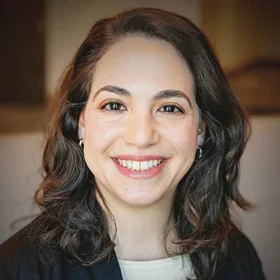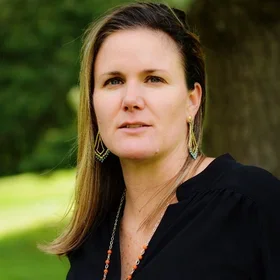Executive Technology Management alumna Samantha Wilmot always had a high-powered career, from leading enterprise-wide risk, performance, and cost metrics and reporting to leading global IaaS cloud computing services. After earning her master’s degree from Columbia, Wilmot took her career to the next level. She secured the role of Vice President of Strategic Programs at Xerox and in January 2021, was promoted to VP & General Manager of CareAR, Xerox’s augmented reality smart service company. Wilmot recently ruminated on her career path and her involvement as a Course Associate for Columbia’s Technology Management program.
How did Columbia’s Executive M.S. in Technology Management program play a role in your career advancement?
The program has had a profound impact on my life. It opened my eyes to what was out there: opportunities, business, the future—and so much more to learn every day! I was following a well-trodden curated career path in financial services. I look back now and realize I was limiting myself. The Columbia program unclipped my wings, and that made me demand of myself a new direction and new career opportunities. I made the jump to another industry, as well as a different function, and I haven’t looked back. Every day is now another chapter of development. I have gained so much in eighteen months. I now know how to run a company overall, and who to surround myself with. When I started my capstone project for the program, aspiring to start an Augmented Reality product—I knew about the technology but not enough about many other aspects of starting, building, and scaling a company. The Technology Management program set me up with a solid foundation on which to develop. I gained all this from the curriculum, my mentor Jorge Rodriguez, the incredible faculty and staff at Columbia (including those not directly involved with delivering the Technology Management program), as well as the network of peers I found, who are so supportive and continue to be friends for life. I would say the program was one of those pivotal points in my life where I was launched into a significant next chapter, as it could for all students in the program if they’re willing and open to it!
The Columbia program unclipped my wings... I made the jump to another industry, as well as a different function, and I haven’t looked back. Every day is now another chapter of development... I now know how to run a company overall, and who to surround myself with."
Tell us about your involvement in Columbia’s Technology Management program now.
I was honored to be invited to support the Executive Seminar Semester II class. I support Professor Mark Mooney and am joined by Mike Brito. Both are amazing teachers with rich experiences that they generously share in their mission to help the students succeed. The class is the second of three segments that develop the main capstone project of the course. The semester I am teaching focuses on business planning for a technology project, the idea for which must come from the student. An executive mentor also supports the student: a significant differentiator for this Executive Master’s program, over MBA programs.
It is incredibly rewarding to teach, as I find that students’ questions in turn help me learn more. Sometimes, I get questions I may not have thought of, or I have to give answers that I have never quite articulated before. Helping others to understand a lesson on a concept is in itself a valuable lesson in communication, on top of learning about the concept itself. Encouraging curiosity and a love of learning is a passion of mine, and I have license to do it while supporting this course! Helping the students along their journeys—a journey which I have taken—is very rewarding. I feel that I can help the students gain what I gained from the program, as well as what I have learned since.
There are two big lessons I see that are reinforced by circumstances we have seen before now. The first is that a technology foundation that is built for change will help the company survive. The second is that the human spirit has a drive for solving problems. When you bring these together, you have a potent mix to get through many kinds of disruption."
Nearly a year into the pandemic, what has emerged as the biggest lesson(s) learned in business and IT transformation, especially in the virtual office setting that many companies find themselves in now?
I work for one of the tech industry’s leading digital transformation leaders, Steve Bandrowczak. His brilliant reflection, “Today is the slowest technology will ever be in our lifetime,” went into overdrive last year. In a matter of weeks, the world went digital—communications, shopping, working, insurance. Very little was unaffected. There are two big lessons I see that are reinforced by circumstances we have seen before now. The first is that a technology foundation that is built for change will help the company survive. The second is that the human spirit has a drive for solving problems. When you bring these together, you have a potent mix to get through many kinds of disruption.
My personal experience regarding building with change in mind, goes back to my days as a developer learning my trade at Morgan Stanley. I learned to write code and build systems on the assumption that they would have to change eventually and continually. Often, it was just weeks after the first release, and I would be adding further enhancements to solve for the next business opportunity or regulatory demand that just came up. In a recent article, my Columbia mentor, Jorge Rodriguez, summed it up: good enterprise architecture and a foundation of people, process, and technology prepares you to respond to disruption.
As for the second lesson about the human spirit: since the start of the pandemic at Xerox, we were able to adjust to a tsunami of change by the strength of our character, convictions, and the drive and boldness of our senior management team. I am so proud to be working at Xerox with the caliber of colleagues who have helped one another every day.
What role can leaders in technology play in creating a “new normal” this year?
So far in 2021, the pace of 2020 continues. Generally speaking the “new normal” is a strange combination of intense work and change, against a backdrop of a locked down life. All while a major historical drama plays out and affects every aspect of our lives. Any leader must consider how that affects their team players.
As a technologist, this climate continues to provide major opportunities. The “new normal” is a world comfortably immersed in digital. As leaders, we look to keep pushing the envelope in technology to solve problems people didn’t even realize they had, and now we can solve them at a speed no one previously thought possible. In my new role as General Manager of CareAR, we make expertise accessible digitally and instantly on an augmented reality smart service platform. It caters to remote working: experts can be based anywhere on the planet to solve customers’ installation and maintenance queries. Instead of our customers having to wait for a site visit, while potentially losing revenue due to down time, we can walk them through a faster solution using augmented reality. With the same tool, our customers can also be connected to their customers in ways previously unimaginable. The visual nature of the application bridges the imagination gap, and reduces or eliminates lengthy verbal or email exchanges. Sam Waicberg, CEO and Co-founder of CareAR, calls it Augmenting Intelligence, providing a great way to weave the personal connection into a seamless digital experience.
The “new normal” is a continuum of new and refined digital experiences. I am quite certain that by the end of 2021, we are going to have even more digital solutions available than we can even anticipate at the start of 2022.


